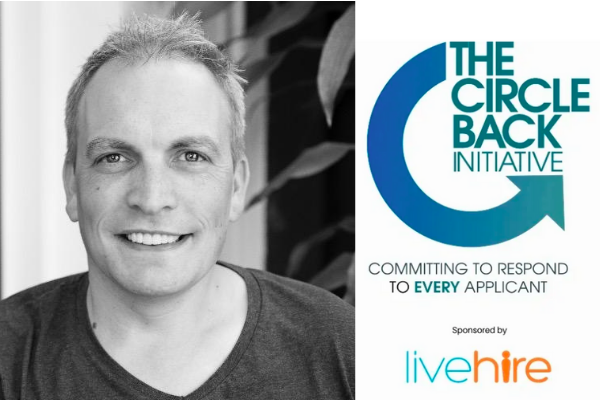The recently founded Circle Back Initiative is a collection of employers who commit to a number of standards on candidate communication. The initiative is gaining traction and is already attracting positive feedback from top talent.
The Circle Back Initiative, founded by Steve Gard of Talentrich, is a commitment by employers to respond to every applicant that applies. The purpose of this initiative is to improve the experience candidates receive after submitting a job application.
After being in talent acquisition for a number of years, Gard established Talentrich to assist talent acquisition functions in corporates around the world. He also supported provided training to recruiters to help them improve their capabilities. Unfortunately, during COVID-19, this work became scarce, as it was difficult to get onsite.

“With this spare time, I volunteered for Jobs for Australia, doing jobseeker coaching over Zoom,” said Gard. “I saw their hope and anxiety –in the amount of effort they put it in to get their CVs right and preparing for interviews–and saw so many of them not hearing back about their applications. I thought, ‘what can we do to change this?’”
Many of us will be familiar with the job ad statement: Only shortlisted candidates will be contacted.
Gard was determined to change this negative terminology into something positive. This lead to the Circle Back Initiative.
The five employer standards
As part of the Circle Back Initiative, employers commit to the following five standards:
- Every applicant receives an “application received” email
- Every unsuccessful application receives an outcome email
- Every candidate online assessed or phone interviewed receives an outcome email
- Every candidate interviewed receives an outcome/feedback call
- Job adverts do not include statements such as: “only shortlisted candidates will be contacted.”
“Employers sign up and commit to the initiative. Hopefully, with a collective of employers making this commitment, it will become the norm for every candidate to receive feedback.”
In positioning the initiative, it’s tempting to promote benefits for the employers. For example, positive employer branding and customer retention (as applicants are often customers). Interestingly, however, Gard steers clear of this.
“My priority is the welfare of jobseekers during this time. Being ghosted is massively impactful.”
“Every article I read about candidate care talks about the benefits for employers. Right now, many people are involuntary jobseekers. As employers, we’re asking them to apply. The very least we can do is respond. Of course, there are benefits for employers. But my priority is the welfare of job seekers during this time. Being ghosted is massively impactful. Employers should have the tech and processes to respond.”
Owning the outcome
While many HR teams are experiencing pressure right now, there are tools and strategies that make delivering communication to candidates not only possible, but easy.
“It’s a communication strategy and a mindset,” says Gard. “Employers shouldn’t just think about how to fill the role, but how they’re going to create a great experience for all candidates who apply.”
For Gard, it’s about managing applications in a “human” way and treating everyone with the respect their application deserves.
“Employers need to have this mindset when they’re going to market. For example, you know you’ll receive hundreds of applications. Yes, you have to fill the role, but we have to own both sides of the outcome, not just the one that suits.”
Gard suggests assessing your attraction strategy, selecting your sourcing channels strategically and being more targeted in response. Be clear on job ads and create desire for the role, but allow candidates to make the decision about whether it will be right for them before applying.
“There’s no excuse not to respond to and handle applications. There are so many tools and tech out there that does all this for you in a few clicks. Even if you’re a small business or recruitment team, there are many low-cost and even free options available.”
Complete a regular review of your candidate experience (even going through it yourself as a test). Assess opportunities for improvement.
Reviews and employer branding
Reviews have a massive impact on recruitment strategy.
“We’re seeing consumers and candidates relying on recommendations more than ever before. It’s paramount your candidate experience strategy is well-designed, even extending to third-party review sites. Are you responding to reviews on Glassdoor and Indeed? They’re not going away, so any feedback you receive on these sites should be used to improve your overall processes.”
Check out the article: You’re never too small for employer branding
What candidates say about the Circle Back Initiative
The Circle Back Initiative has already garnered positive feedback from candidates.
“A candidate applied for a position with one of our registered employers. During their interview with the employer, they said they saw the Circle Back Initiative badge on their job ad and investigated. They said that was what made them apply for the role; because they knew the employer took the ‘people’ factor seriously. Having this mindset means thinking about the people behind the applications.”
The current candidate market
Gard states there’s nothing worse than looking for opportunities and getting ignored. It certainly doesn’t contribute to positive mental health during what has been, for many, a challenging year.
Issues surrounding candidate feedback are compounded by the number of involuntary job seekers in the market. With more competition, comes more anxiety and stress.
“It was challenging for me too, as I was looking for roles – and I understand how recruitment works. If I’m being treated this way, it’s even harder for other candidates not receiving responses and not knowing why.”
“Some employers are reluctant to deliver bad news. But if we’re are asking people to be resilient and keep applying, we need to support them by letting them know where they stand. This matters to candidates absolutely.”
So far, employers of various sizes across a range of industries have committed to the Initiative.
“We’re happy we have such a broad mix of employers because it proves it’s possible to get back to everyone. Some of these employers are going above and beyond the five minimum standards, for example, by giving more detailed feedback earlier in the process. Their processes are so much more transparent, and not as ‘transactional’, It’s about relationship building.”
For more information and to sign up, visit the Circle Back Initiative website.
What is your organisation’s approach to candidate care? What tools and strategies do you use? Share a comment below.


2 comments